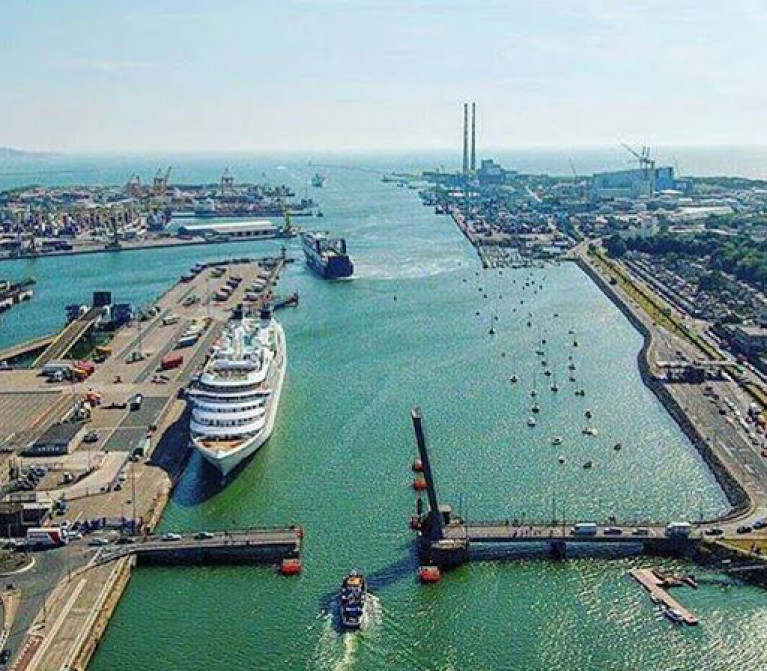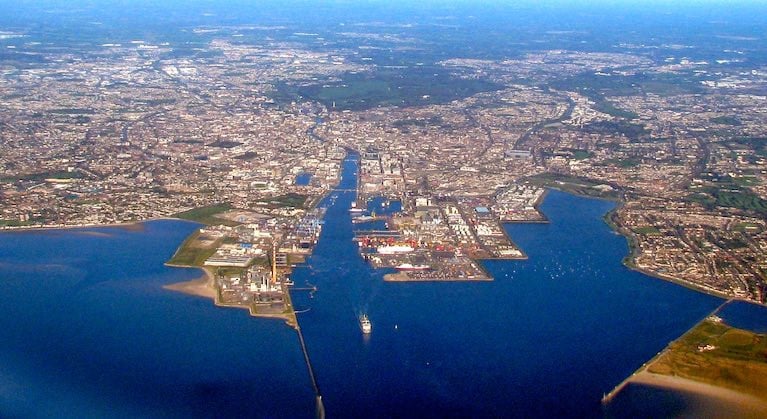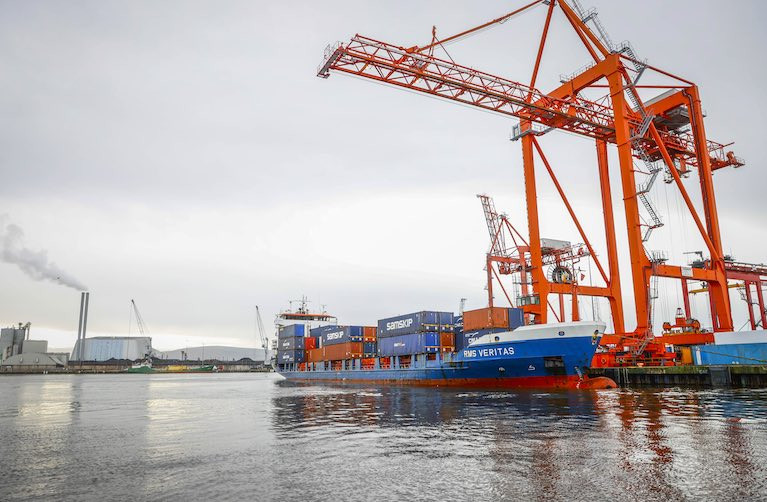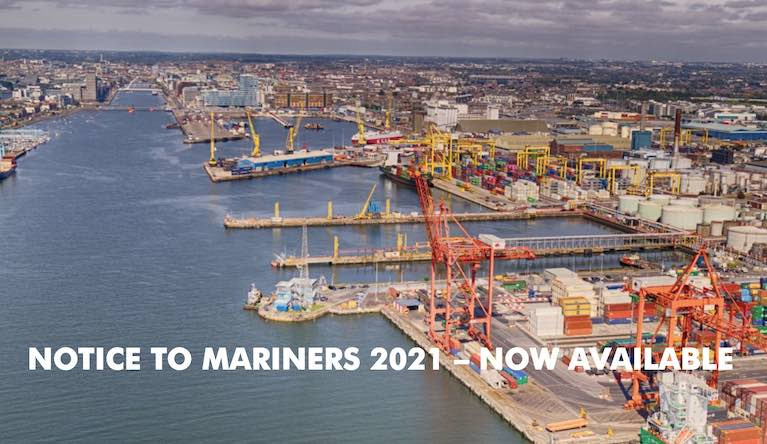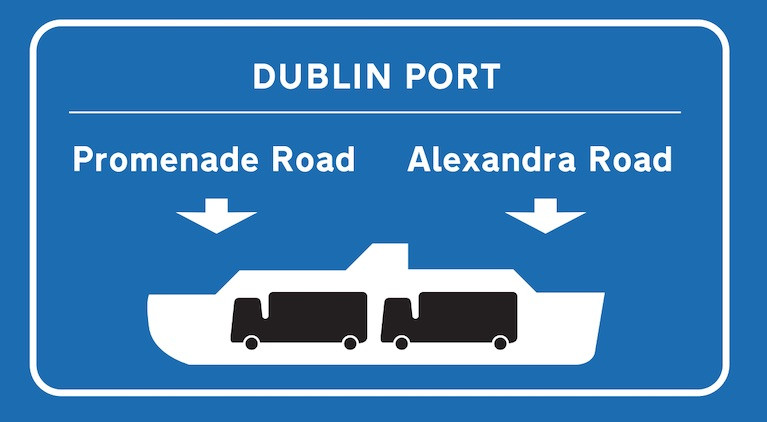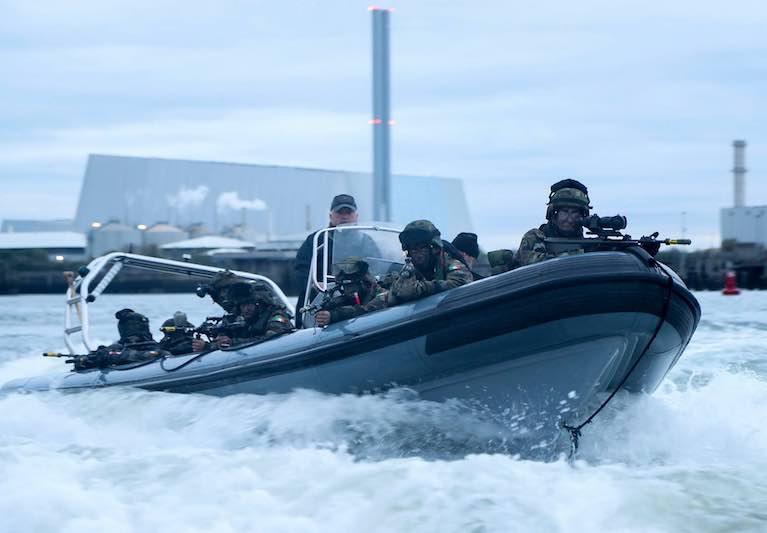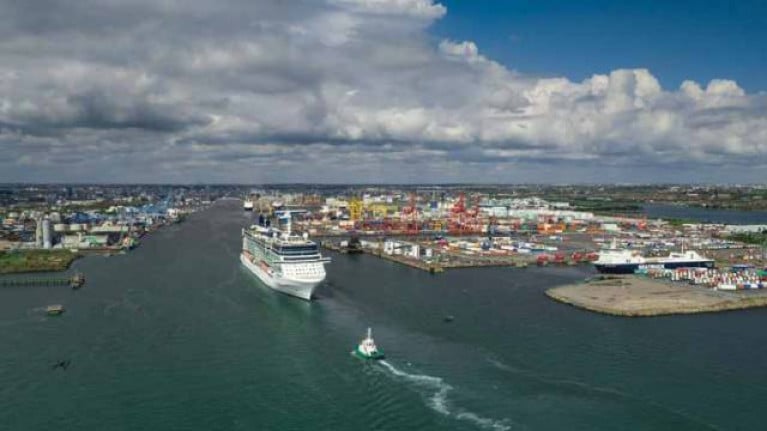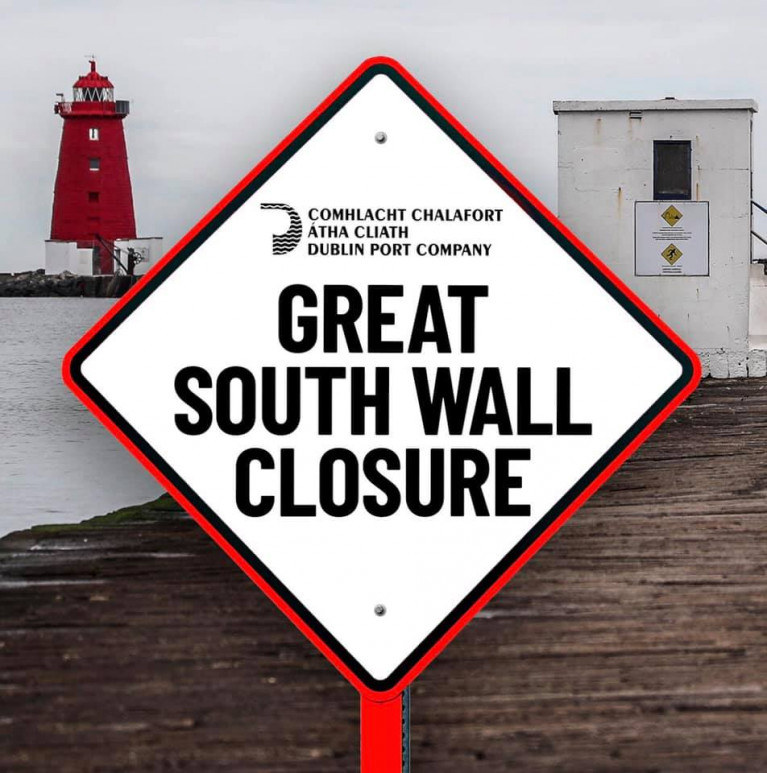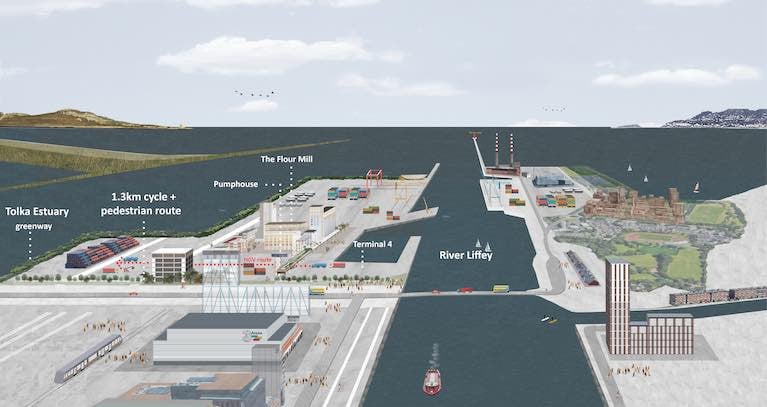Displaying items by tag: Dublin Port
The notion of a rail and possibly road tunnel linking Northern Ireland and Scotland is once again a matter of speculation, and a Discussion Paper will be published by the British Government “within weeks”. Eleven months ago, before Brexit had been set in place and Covid-19 had really taken hold, Afloat.ie took a serious look at all the options in light of the fact that the busiest route between Ireland and Britain at the time was the Dublin-Holyhead crossing, while pressure on space in Dublin Port suggested that some out-of-the-box thinking was required. We re-publish that article of April 2020 in the knowledge that much has changed in the meantime, but the hydrographic and geographic reality remains the same.
In recent months the concept of a fixed link between Ireland and Britain has been rapidly developing as various politicians have proposed bridges between Northern Ireland and Scotland across the narrow, storm-tossed and tide-riven waters of the North Channel.
But while the distance between Fair Head on the northeast corner of Antrim and the Mull of Kintyre in West Scotland is barely 13 miles, as one critic has pointed out, this would be a link “from the back of beyond to the middle of nowhere”. For even when Scotland has been reached at Kintyre, any traffic would have hundreds of miles of driving before getting anywhere near the main road system, let alone the primary motorway routes.
As for a connection across the established ferry route between Larne in Northern Ireland and Stranraer in southwest Scotland, that would also bring traffic from Ireland into a relatively remote part of Scotland, with a long slow drive to the nearest part of the motorway system towards Carlisle in northwest England. That in turn then involves a long haul through the notoriously congested M6 in order to connect with other main routes into the prosperous southeast of England and on into mainland Europe.
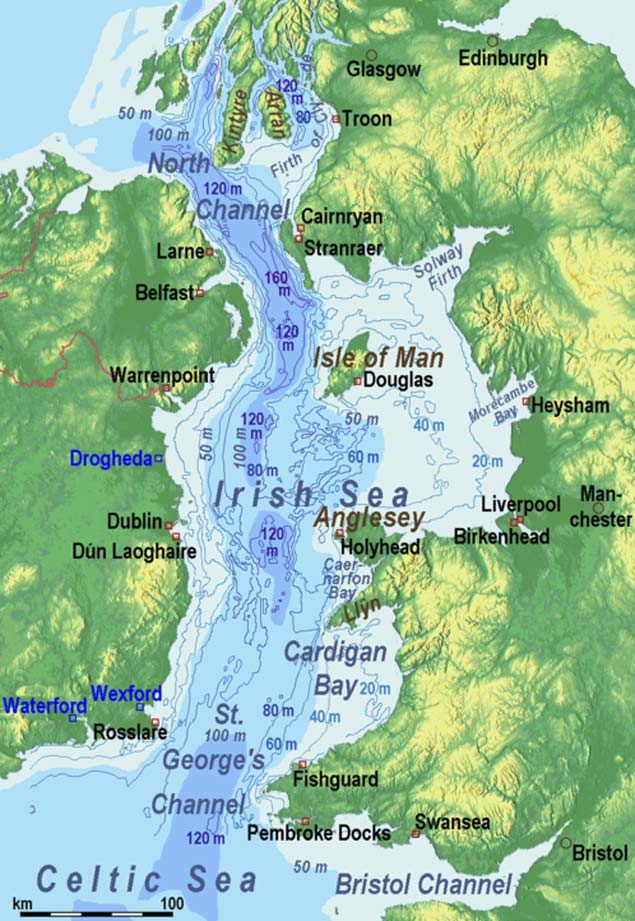 The challenges of providing a fixed link between Ireland and Britain are abundantly clear in this image, with the 160 metres depth of the explosives-filled Beaufort Dyke in the southern North Channel clearly in evidence. In terms of providing a relatively level seabed for the proposed Brunel Link from the greater Dublin area to North Wales, it looks as though a straight line between Skerries and Holyhead would offer the best option
The challenges of providing a fixed link between Ireland and Britain are abundantly clear in this image, with the 160 metres depth of the explosives-filled Beaufort Dyke in the southern North Channel clearly in evidence. In terms of providing a relatively level seabed for the proposed Brunel Link from the greater Dublin area to North Wales, it looks as though a straight line between Skerries and Holyhead would offer the best option
But in any case, it has been pointed out that a Larne-Stranraer link would be considerably longer than the shorter County Antrim link between Black Head in Northern Ireland and Corsewall Point in Scotland. Yet both of these would involve difficult shoreside access, whereas a link slightly further south from Donaghadee in County Down through the nearby Copeland Island and across to Portpatrick in Scotland is only about 20 miles, although putting a motorway through the choice residential districts of North Down and across Copeland Island might meet with some local resistance.
In any case, in this area, the North Channel includes the 160 metres deep fissure which is the Beaufort Dyke, a hidden depth which has the added hazard of use as a dumping group for explosives – millions of them – after World War II ended in 1945. Even after 75 years, there is no reason to assume that they still are anything other than extremely dangerous.
Yet in theory, a viable bridge could be built at this point, for civil engineers reckon anything is possible if they’re only given enough resources to do it. Nevertheless, even though it might be less expensive than a tunnel, it boggles the mind to think of the expenditure which would be required to create a bridge structure which could withstand the really extreme conditions of the North Channel, and thus another idea which has been around for some time has been put forward as a possible solution.
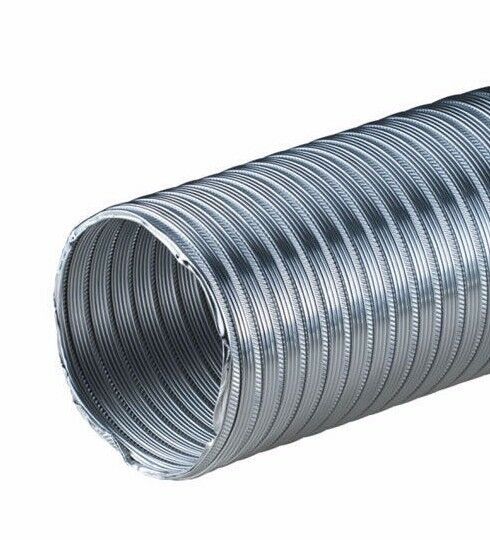 The basic structure of the Brunel Link is very simple. In the completed full-size project, a motorway standard dual carriageway with three lanes either side will be in place across the middle, while a two-line railway will run along the floor.
The basic structure of the Brunel Link is very simple. In the completed full-size project, a motorway standard dual carriageway with three lanes either side will be in place across the middle, while a two-line railway will run along the floor.
This is the Bridge/Tunnel, the “Brunnel”, which is somewhere between a bridge and a tunnel. It is in effect a giant tube which is laid along the sea-bed in such a way that it flexibly follows the contours when they are reasonably even, but by its nature, the structure can be reinforced to become a rigid tube-bridge when it is necessary to cross an undersea valley.
As the portmanteau name of Brunnel is so near to the surname of Brunel to remind us of the great Victorian engineer-builder Isambard Kingdom Brunel (who would be just the man for a massive and visionary project of this nature), the concept is becoming known as the Brunel Link. And its potential for being extruded in virtually infinite lengths by a giant (and we really mean giant) tube-making machine from a reinforced mixture of concrete and advance epoxies has been taken into consideration by a mysterious Dublin-based organisation known as the Committee for the Re-Alignment of Ports.
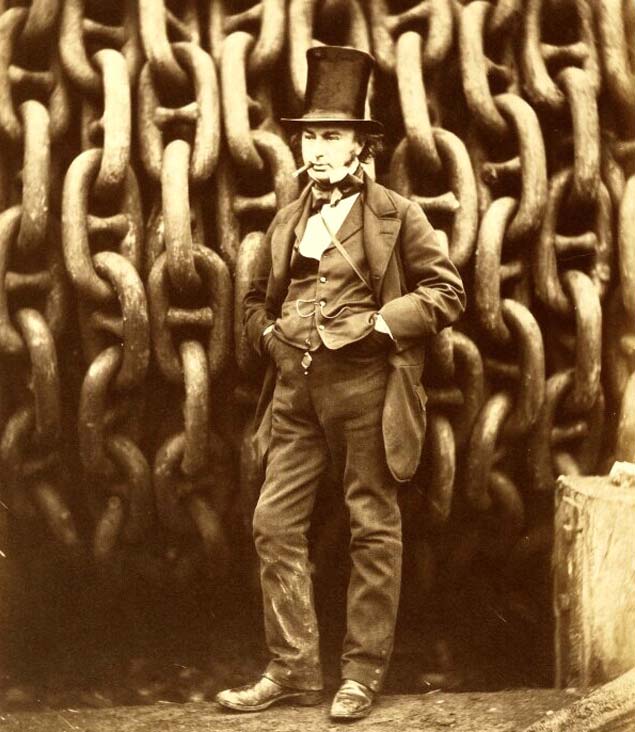 The greatest engineer? Isambard Kingdom Brunel (1806-1859) has been deservedly honoured in the name of the Brunel Link.
The greatest engineer? Isambard Kingdom Brunel (1806-1859) has been deservedly honoured in the name of the Brunel Link.
Basically, this Committee is primarily concerned with connecting Ireland as directly as possible with the most prosperous and industrious part of middle and southeast England, which in turn gives connections into the commercial, financial and industrial heartlands of Europe. In order to achieve this, they have concluded that the key arterial route to be followed would be based around the Dublin to Holyhead route.
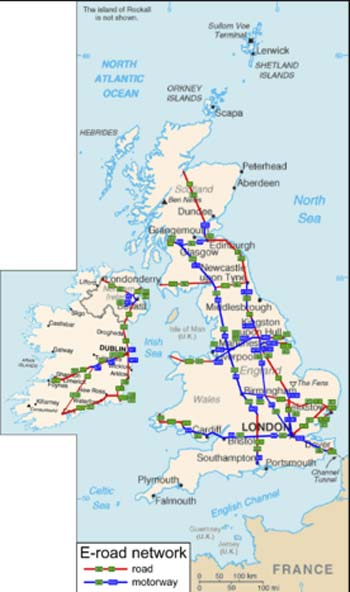 The logic of the Dublin-Holyhead link as the most efficient inter-connector from the island of Ireland to Britain’s industrial and commercial heartlands and on into mainland Europe is evident from this map of the main routes
The logic of the Dublin-Holyhead link as the most efficient inter-connector from the island of Ireland to Britain’s industrial and commercial heartlands and on into mainland Europe is evident from this map of the main routes
Thus the Committee’s plan is for a Brunel cross-channel tube connection from somewhere on the coast of the Greater Dublin region to Holyhead, the structure to be of sufficient diameter to accommodate a dual carriageway motorway with three lanes either side, plus vitally important hard shoulders, at its widest horizontal diameter, and below this would be a twin-track railway system running along the Brunel Link floor which will somehow accommodate the differing railway gauges to be found on either side of the Irish Sea.
As the impetus for this huge project is essentially coming from the Irish side, the group behind it plan to invest heavily in Holyhead harbourside property. In fact, one development of this idea is that Ireland should buy Holy Island, the offlyer beside Anglesey on which Holyhead is located, and make it in effect an extension of the Irish Republic. Ideally, in fact, the promoters would like to take over the entire island of Anglesey to provide Dublin with the potential for an easterly extension and its useful hinterland.
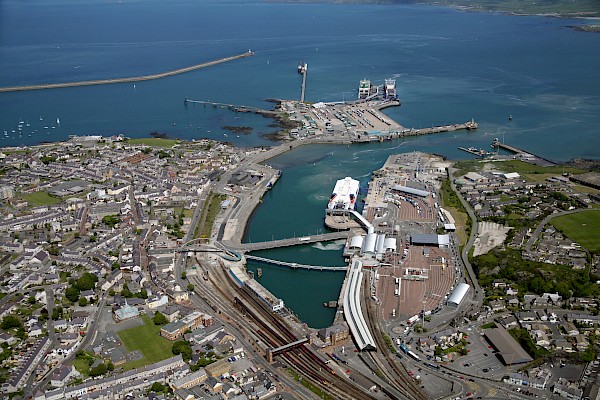 With the Brunel Link in place, the port of Holyhead could have a brighter future as an extension of Dublin Port.
With the Brunel Link in place, the port of Holyhead could have a brighter future as an extension of Dublin Port.
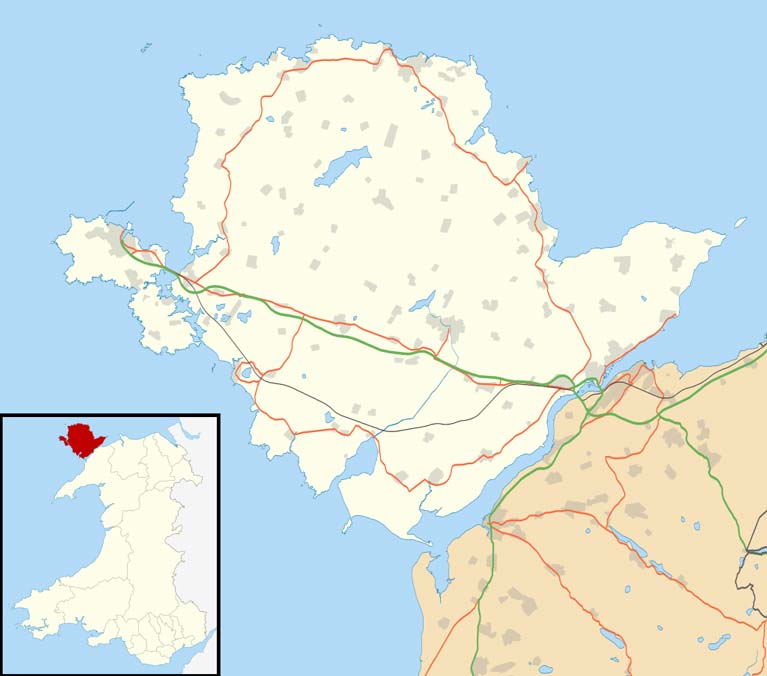 The promoters of the Brunel Link are thinking in terms of initially taking over Holy Island on which Holyhead is located, and ideally, they hope to buy all of Anglesey in due course to provide Dublin with a viable eastern hinterland.
The promoters of the Brunel Link are thinking in terms of initially taking over Holy Island on which Holyhead is located, and ideally, they hope to buy all of Anglesey in due course to provide Dublin with a viable eastern hinterland.
At the moment that is only the stuff of dreams, but with the Brunel cross-channel connection, the entire geography of the northern area of St George’s Channel would be changed. With Anglesey less than an hour’s drive away from Dublin regardless of the weather, Holyhead could be transformed from an economic blackspot into becoming part of one of Europe’s most successful technical and financial hubs.
This ready access to Holyhead would, in turn, add another option to the regularly-issued demand by high-flown economic commentators and urban planners that Dublin Port be moved entirely out of the city in order to facilitate the “proper 21st Century potential” of the Capital. Those of us who think that the regular and much-observed ship movements in and out of the Port and Dublin Bay are integral to the character of the city may disagree with this, but nevertheless, it’s interesting to see how the Holyhead option may affect the overall thinking.
For the “Move the Port out of the City” movement assumes that somewhere else can be conveniently found to place the large and complex infrastructure of Dublin port. Yet no remotely comparable natural harbour exists any nearer than Carlingford Lough to the north, and Wexford Harbour to the south, while the proposals for a new port at Bremor close north of Balbriggan seem to take no account of the need there would be for the construction of massive new breakwaters to create an artificial harbour which would have to be many times the size of Dun Laoghaire.
Yet with Holyhead brought into the equation through the Brunel Link, valuable land on the East Coast of Ireland could be retained for residential and recreational use, while an under-utilised industrial area and harbour on the Welsh coast could be brought to life as an extension of Dublin port.
 Sunset for Dublin Port? With ferry operations removed by the opening of the Brunel Link to Holyhead, and with Holyhead thereby enabled to take over the freight services of Dublin, the way would be clear for the Dublin port area to be re-developed for residential, office and recreational use.
Sunset for Dublin Port? With ferry operations removed by the opening of the Brunel Link to Holyhead, and with Holyhead thereby enabled to take over the freight services of Dublin, the way would be clear for the Dublin port area to be re-developed for residential, office and recreational use.
Behind all this re-alignment of ports, the new arterial connection from the heart of Ireland through Britain to the heart of Europe would be made even more viable in several obvious ways. With the rapidly increased use of electrically-powered vehicles in the near future, the convenience and environmental compatibility of the Brunel Link, and the inescapable logic of its location, arguably make the visionary proposals from the Committee for the Re-Alignment of Ports a real no-brainer.
Dublin Port's Future Lines of Development Affect Us All
Dublin and its Port. The City and the Sea. The Culture and the Commerce. The Buzz and the Business. The sense of real working and creative life, with the romance of the ocean and the hint of salty far horizons, vibrantly cheek by jowl with a thriving yet cosy civic core in a strong dynamic that inspires art and literature while providing a special enjoyment of life.
That's Dublin. There really is nowhere else quite like it. And therein lies the problem. For although CEO Eamonn O'Reilly and his team running Ireland's largest and expanding port have direct links with comparable city ports elsewhere, and have closely studied the solutions provided by those of broadly similar size such as Helsinki, the fact is that the unique nature of Dublin's relationship with its relatively small but optimised river flowing into the elegant bay framed with beautiful hills and mountains…..well, it means that Dublin has to find its own solutions.
The importance of this is indicated by the fact that its future is a matter of serious public debate, with plans being published and up-dated with continuous re-planning being a part of the process - as it should be in a constantly-changing situation.
 Unusually among capital cities, Dublin continues to retain its port in the heart of the city, and it is very much part of the city's unique character
Unusually among capital cities, Dublin continues to retain its port in the heart of the city, and it is very much part of the city's unique character
 Working port and serene seaside suburbs – looking north across Dublin Port across the Tolka Estuary to Clontarf
Working port and serene seaside suburbs – looking north across Dublin Port across the Tolka Estuary to Clontarf
Thus around the turn of the Millennium, the notion of moving the basic operations of the port elsewhere came top of the agenda, and many of us were in favour of this, or a partial version of it. But when the Port Tunnel opened in 2006 as a hugely successful traffic pressure relief valve, we found ourselves – or at least I did – coming round to the idea that having an active, purposeful and comprehensive yet historic port in the heart of the city was central to Dublin's character, such that with the Port Tunnel in place, it was now surely everyone's duty to make better use of the fine facilities which had developed over the centuries as the city was reclaimed eastward.
 Before the Port Tunnel was opened in 2006, schemes for the re-location of Dublin Port abounded, and this was the proposal by one now-defunct political party for high-rise development on the Poolbeg Peninsula. The beloved "Poolbeg Stacks" are just about visible in the midst of it all, but today this imagined setup would probably be seen as a perfect Pandemic Incubation Complex
Before the Port Tunnel was opened in 2006, schemes for the re-location of Dublin Port abounded, and this was the proposal by one now-defunct political party for high-rise development on the Poolbeg Peninsula. The beloved "Poolbeg Stacks" are just about visible in the midst of it all, but today this imagined setup would probably be seen as a perfect Pandemic Incubation Complex
That what they used to call it: "Reclaim". It was as though the nefarious sea had spent thousands of years furtively pinching bits of the gallant Irish nation's sacred territory, and it was our patriotic duty to get it back by glorified dumping. These days in a more ecologically-aware era, it's more often called "infill". But either way, it is now deployed sparingly, even if the port and many choice parts of the city beside it are firmly located on what used to be sea and beach and muddy foreshore, so much so that when the first grand houses were built on the south and west sides of Merrion Square, they were marketed as giving proximity to the sea, and providing the finest nautical views.
The fact that the sea and ships are still but a couple of streets away has been recognized as central to Dublin's character by town-planners such as Patrick Abercrombie in 1916. That year, certain other events were taking place around the GPO, so his plans weren't published until 1922. With them, he argued that, given a choice, most people in a coastal city such as Dublin would prefer to live near the sea. And he claimed to have made this newly possible for thousands in his plans by indicating further extensive land reclamation in the Tolka Estuary to the north of the Liffey, and what we might call Irishtown Bay to the south of the Poolbeg Peninsula, and then going on to turn both new areas into attractive coastal garden towns – Welwyn-Garden-City-on-Sea with an Irish flavour, as you might say.
Now I may be missing something here, what with pandemic brain fog and so on. But it seems to me that if you turn the Tolka Estuary and Irishtown Bay into garden suburbs, then it means that, at a stroke, thousands of people who were formerly living in breezy coastal districts like Marino, south Clontarf, Irishtown and Sandymount will suddenly find that they no longer live beside the seaside, much and all as they may have liked it in the old days, when their daily inhalation of sea air and an awareness of ships coming and going into Dublin port was so much a part of life, with the Tolka Estuary and Irishtown Bay essential lungs of the community.
 The Abercrombie Plan – it was claimed that it would give thousands of people new access to coastal living. But by completely in-filling the Tolka Estuary and Irishtown, it would actually have cut off thousands of long-established residents from their cherished coastal living…..
The Abercrombie Plan – it was claimed that it would give thousands of people new access to coastal living. But by completely in-filling the Tolka Estuary and Irishtown, it would actually have cut off thousands of long-established residents from their cherished coastal living…..
Going back into history, it was undoubtedly necessary at one stage to build the port city eastwards towards the sea, as the mediaeval Dubh Linn – the Black Pool – up by Dublin Castle could only accommodate ships which soon seemed small by comparison with the next generation of sailing vessels, which in turn seem tiny to us now.
And unlike ports in the Baltic and the Mediterranean, Dublin had to accommodate a tidal range which was not large enough to justify locks in the dock entrances, but was quite enough to be a key factor in any harbour planning and construction costs. The story of how, over the centuries, the limited power of the ebb in the modestly-sized River Liffey was harnessed through training walls to create and maintain a deepwater channel, and a navigable passage through a bar which at one time could be forded on foot at extreme low water spring tides, is part of the romance of the story of Dublin port.
 As the port has gradually moved downriver, its nautical character has been retained with the 19th-century sailing ship Jeannie Johnson berthed in the Liffey beside new office developments
As the port has gradually moved downriver, its nautical character has been retained with the 19th-century sailing ship Jeannie Johnson berthed in the Liffey beside new office developments
But as we've been indicating in various articles in Afloat.ie over the years, and most recently mentioned in our report of a feature on RTE's Nationwide, Dublin Port is approaching optimal expansion with planning approval granted for the final eastward development – MP-2 (Masterplan 2).
The permission sought was for fifteen years, as changing circumstances will inevitably alter requirements and project timescales. But ultimately Dublin Port's thinking is that by 2040 they'll be working to full capacity, and thus by 2030 a basic strategic plan should be in place as to how ship berthing and cargo handling facilities and logistics can best be handled along the East Coast of Ireland.
 Topped up – the most easterly proposed development indicated in the MP2 plan. Based on pre-pandemic trends, these final berths may see Dublin Port reaching full capacity by 2040
Topped up – the most easterly proposed development indicated in the MP2 plan. Based on pre-pandemic trends, these final berths may see Dublin Port reaching full capacity by 2040
For although the West Coast is blessed with the naturally-advantaged Shannon Estuary, while the South Coast is in a league of it own with the wonder which is Cork Harbour, on the East Coast even the most sheltered big-ship-accommodating inlet – Belfast Lough – has needed very extensive dredging and harbour construction works to create the Port of Belfast, while the very existence of Dublin as a big-ship port has been as the result of ingenuity and a certain amount of good fortune over the years.
How this all came about, and where it might be going, has been collated in seven fascinating discussion papers which Dublin Port published at intervals through the latter half of 2020. However, what with the pandemic and the developing technical problems of the reality of Brexit, these papers haven't yet properly engendered the public conversation that they merit. But now they're out as a compiled pdf, which you can access by scrolling to the end of this piece.
You'll find that this is a comprehensive, informative, fascinating and at times entertaining collection which, if nothing else, makes for perfect pandemic reading. And it makes you realize that the people running Dublin Port, led by Eamonn O'Reilly and inspired by Heritage Director Lar Joye, have a profound insight into the deeper meaning of the symbiotic relationship of the city and its harbour.
 Eamonn O'Reilly, CEO of Dublin Port. Photo: RTE/Screenshot
Eamonn O'Reilly, CEO of Dublin Port. Photo: RTE/Screenshot
 Lar Joye, Heritage Director of Dublin Port. Photo: RTE/Screenshot
Lar Joye, Heritage Director of Dublin Port. Photo: RTE/Screenshot
But before we go into a summary of what it all might mean, here's a snippet of information which recently emerged from Rome on December 5th 2020. While we may have suggested that Dublin's situation is so unique that the city has largely had to find its own way through solving its port conundrum, nevertheless we might make an exception for port news from the Eternal City. For it seems that no sooner had an initial €300 million been allocated to parts of Italy from the EU Recovery Fund than the Mayor of Rome, Virginia Raggi, staked a claim for it to be used to restore the River Tiber to a navigable state which would permit ships to be berthed once more in the heart of the city.
For, like many cities, Rome has long since seen its commercial port located further and further from the heart of town. But the creation of a commerce-free waterway through town contributes to the city it used to serve becoming something of an empty husk of a place, a sort of Disneyland of a city. If Disneyland is your thing, then that's fine and dandy. But many who live and work in Dublin are quietly happy that their slightly eccentric hometown is a living breathing seaport rather than a glorified film set.
 The River Tiber in Rome is of a size comparable to the Liffey in Dublin. Rome's seaport is now far from the city, but the Mayor wants to bring ships back to town.
The River Tiber in Rome is of a size comparable to the Liffey in Dublin. Rome's seaport is now far from the city, but the Mayor wants to bring ships back to town.
But a living breathing seaport has to be a viable commercial and logistical operation. So if we're facing a scenario where Dublin Port is approaching saturation by 2040, what's the plan?
Admittedly in these hyper-volatile times, such predictions of saturation may be changing by the day, what with changes in the way we live and work, changing in manufacturing techniques, and changes in travel and transport patterns. So really there's no plan, just ongoing planning, for we can only follow the mighty economist John Maynard Keynes who - when accused in a personal attack of changing his mind in a big way – riposted with vigour: "When circumstances change, I change my mind. What do you do?"
So by the time we can hope to get a clearer picture of where the world has got to in the coming Autumn, it may well be that those developers who would wish to take over swathes of dockland to build high-rise offices and apartments will find that the need for offices has shrunk, while potential flat-dwellers will have come to see dense apartment blocks as perfect pandemic incubation units, with that Irish desire for a bit of green space – however tiny – setting the property agenda.
And yes, I do know that recently the Dublin City senior planner has announced that the days of the three-bed semi-detached house "are over" and the future is in apartments, but presumably he somehow enjoyed lockdown and WFH in an apartment while the rest of us were sustained largely by the proximity of our little gardens.
As for Dublin Port reaching saturation, it's equally likely that by 2040, the shipping and stevedoring industry will have devised more efficient ways of using the facilities available, while the greater integration of the port with the city by means of safe cycle-ways, protected walking trails, and accessible user-friendly public spaces will have enhanced the sense of Dublin Port being an attraction to be cherished, rather than a totally utilitarian necessity which is best shunted off elsewhere.
Nevertheless Dublin Port have outlined other options in their discussion papers, and the real meat on that comes in Papers 5,6 and 7, where they address the possibility of additional or alternative facilities through DP2.0 at Bremore on the northern tip of Fingal which - under some pieces of legislation - is still seen as being in County Dublin, or else at Arklow in County Wicklow.
 Dublin Port's outline of the scale and quality of design which would be required in a completely new harbour at Bremore in Fingal
Dublin Port's outline of the scale and quality of design which would be required in a completely new harbour at Bremore in Fingal
 Building a proper port at Bremore would be a complex and very expensive project
Building a proper port at Bremore would be a complex and very expensive project
It's a sobering document for those who blithely talk of building completely new big-ship harbours on what is an exposed east-facing coastline. Anyone who thinks that Ireland's east coast is snugly sheltered from the prevailing westerly winds would do well to remember that wind patterns have changed somewhat, and Storm Emma in March 2018 – the Beast from the East – very forcefully indicated the kind of conditions that a 24/7 port at Bremore or Arklow would have to be capable of withstanding.
 Dublin Port's outline proposals of the harbour requirements which would be needed at Arklow
Dublin Port's outline proposals of the harbour requirements which would be needed at Arklow
 As at Bremore, a new port at Arklow would require extensive shoreside development in addition to massive breakwaters
As at Bremore, a new port at Arklow would require extensive shoreside development in addition to massive breakwaters
But in the spirit of the brief for their Discussion Papers, Dublin Port has done thorough research and conceptual design work on these possible developments. Even the most basic breakwater construction works on such facilities will not come cheap, and at mid-2020 costings (which will have already risen) Arklow comes in at €3.9 billion, while Bremor would be higher again, at €4.2 billion.
With the costs of associated shoreside infrastructure still to come, those figures are only by way of a deposit, while beyond all that there's the environmental impact, increasingly a matter of public concern, and very valid in these cases.
A telling paragraph in Paper 6 puts it in perspective:
"Because Dublin Port is nestled into Dublin Bay and along the banks of the Liffey, it can be difficult to appreciate its scale. For example, the distance from the Tom Clarke Bridge to the end of the easternmost berth in Dublin Port is almost three kilometres. It is a further two kilometres from this point to the entrance to the port at the Poolbeg Lighthouse. Dublin Port is concave; DP2.0 would be convex. DP2.0 would extend 3.2 kilometres into the Irish Sea if built at Arklow, and 4.5 kilometres if constructed at Bremore."
As it happens, the main factor in the nation's economy for the foreseeable future is surely going to be handling the debt incurred from the various pandemic shutdowns. So although some major infrastructural projects might well be promoted as integral to economic vitality and revival, schemes like these totally new harbours – described by planners and engineers as being in the realms of "megaprojects"- are of doubtful real benefit if more effective use of existing facilities can solve the problem and thus leave the necessary funding available for much-needed housing.
Meanwhile, the management and specialists at Dublin Port have given us plenty of material for discussion, and their analyses and conclusions merit serious attention with thoughtful answers rather some headline-grabbing flippant responses.
We'll allow Eamonn O'Reilly and his team the last word:
"Our analysis of these issues in the seven papers of the Dublin Port Post 2040 Dialogue leads to the following conclusions:
Conclusion 1
Dublin Port Company must complete all of the projects outlined in Masterplan 2040 to deliver infrastructure with an annual throughput capacity of 77 million gross tonnes by 2040.
Conclusion 2
Critically, this will require planning permission to be secured for the 3FM Project.
Conclusion 3
The achievement of a throughput of 77 million gross tonnes per annum by 2040 will require not only the completion of all of the infrastructure projects in Masterplan 2040; it will also require that the efficiency of port operations greatly increases so that port infrastructure is utilised to its maximum. This will require the elimination of systemic inefficiencies in existing supply chain operations.
Conclusion 4
Over the next 20 years, additional capacity at other existing east coast ports will be required so that, as Dublin Port approaches its ultimate capacity, volumes which Dublin cannot handle can be accommodated elsewhere.
Conclusion 5
During these 20 years, DPC will need to work on the DP1.5 project so that it can be brought through the planning process and construction started by about 2033 should that become necessary.
Conclusion 6
The projects to provide additional capacity in other ports and the project to construct DP1.5 can only be realised with State support – none of the projects and none of the port companies (including DPC) are capable of raising the project finance that would be required.
These six conclusions will inform DPC's contribution during 2021, firstly, to the preparation of the next Dublin City Development Plan and, secondly, to Government's review of the National Development Plan.
In publishing the seven papers, we have invited others to critique our thinking and to prepare detailed responses including, possibly, alternative analysis which yields different conclusions to ours. The long-term planning challenges faced by DPC are national challenges and it is important that future port capacity plans are formulated on the basis of as detailed a consideration of the issues as is possible."
Download the 'Dublin Port Post 2040 Dialogue' below
Dublin Port Welcomes Samskip’s First Direct Container Sailing Between Amsterdam & Ireland
Dublin Port today welcomed Samskip’s first direct container sailing between Amsterdam and Ireland, with RMS Veritas arriving into Dublin Port at lunchtime, marking the start of a new weekly shortsea container freight service between Dublin and North Continental Europe, while increasing options for importers and exporters post-Brexit.
Dublin Port's 2040 Plan Airs on RTE's Nationwide
Dublin Port Chief Executive Eamonn O'Reilly told RTE One's Nationwide programme this week that the capital's port will reach capacity in 2040.
The CEO said the port, that handles almost 50% of all trade in the Republic of Ireland, faces a huge challenge to build infrastructure to cope with the growth in cargo on the River Liffey over the next 20 years.
As Afloat previously reported details of the port's plan for its future are contained in its masterplan.
O'Reilly's interview featured in RTE One's Nationwide programme on Wednesday evening and can be reviewed on the RTE Player here (scroll to 11.45 on the timeline).
O'Reilly said these were 'extraordinary times' in the history of the port. By 2040, the port will have reached its maximum capacity, some 333 years since the first port authority in Dublin was established.
Dublin Port Heritage zone
O'Reilly also said the port wasn't just focussed on building port infrastructure but is also preparing to open the port to the public.
"We cannot just have the port as an industrial zone and ignore the local community".
As a result, a two-acre site within the port is being transformed into a heritage zone so Dubliners can come down to the Port area and enjoy the experience of having a living working port in the heart of their city.
The Port is also constructing a greenway on the north side at the River Tolka estuary where a four km cycle lane will be provided for leisure purposes.
Elsewhere in the programme, Dublin Port Heritage Director Lar Joye gives a guided tour of port operations as part of the recent Open House architecture festival.
 Lar Joye, Dublin Port Heritage Director Screenshot: Nationwide
Lar Joye, Dublin Port Heritage Director Screenshot: Nationwide
The tour takes in a trip around Alexandra Basin and Joye observes the MV Shingle, a ship seized in 2014 over €14m worth of tobacco that still awaits its breakup and the Kittiwake, an old lightship that is going be restored as part of the new heritage zone.
Joye's interview can be reviewed on the RTE Player here (scroll to 2.14 on the timeline).
Dublin Port Issues 2021 Notice to Mariners, Including 'Dublin Bay Guidance Notes for Leisure Craft'
Dublin Port Company has issued its 2021 Notices to Mariners.
The well-presented page on the Dublin Port website here provides links to over 40 different notices covering all aspects of Dublin Port activity in 2021 at Ireland's busiest port in a bay that contains Ireland's biggest boating population of approximately 1,000 boats at nearby Dun Laoghaire Harbour.
All 2020 Notices to Mariners not previously cancelled were automatically cancelled at 23:59 hours on the 31 December 2020.
Guidance Notes for Leisure Craft
Of particular note to recreational boaters is No.19 of 2021, which sets out guidelines for all leisure craft as set out in the “Dublin Bay Guidance Notes for Leisure Craft” here.
The notice states that when navigating within the approaches to Dublin Port and in the vicinity of the Fairway Channel, it is a requirement that persons in charge of leisure craft must maintain a watch on VHF Channel 12. They should ensure that they keep themselves fully aware of all shipping movements and operations.
 DBSC's New Ross buoy is a yacht racing mark on Dublin Bay Photo: Afloat
DBSC's New Ross buoy is a yacht racing mark on Dublin Bay Photo: Afloat
DBSC Marks on Dublin Bay
Notice number 15 deals with yacht racing marks in the Bay and outlines Dublin Bay Sailing Club 'statutory sanction' to lay the following yacht racing marks within the Dublin Port Limits from April to October.
Dublin Bay Terns
In Notice number 29, all leisure craft are to navigate with due care and attention when in the vicinity of a pontoon located in a position south of the buoyed channel on the River Liffey as it is a nesting site for birds. The 17m x 8m pontoon is moored and lit on both the eastern and western ends with yellow lights. To avoid disturbing the nesting birds, it is forbidden to moor to or go alongside the pontoon.
The 2021 Notices to Mariners page on the Dublin Port website is here
Dublin Port Completes Major Road Works & New Traffic Management Measures in Advance of Brexit
With just over two weeks to go before the re-introduction of border controls on goods arriving from Great Britain, Dublin Port Company (DPC) has today announced:
- The completion of works to increase the capacity of Dublin Port’s internal road network; and
- The introduction of new internal traffic management measures to keep traffic flowing through Dublin Port.
The new measures are being introduced this week and will be in full effect in advance of the introduction of the new border controls on 1st January 2021.
The improvements and changes are detailed in a new booklet, Six Key Messages for Hauliers.
Even with additional road capacity and traffic management measures in place at Dublin Port, all operators and port users have their part to play to keep trade flowing and ensure that extreme contingency plans are not needed in response to congestion. This is especially so in the first 90 days of 2021.
The challenge for State agencies - notably Customs and the Department of Agriculture, Food and the Marine (DAFM) - is to apply border inspection controls efficiently around the clock on six times the volume of goods that were arriving off ferries 28 years ago when the Single European Market removed the need for such controls.
As part of the challenge to prepare for Brexit, eight inspection facilities have been constructed for Customs and DAFM by DPC and OPW at six different locations in Dublin Port. Dublin is already a busy port and the additional requirement for hauliers to move trailers between ferry terminals and these eight different facilities will increase traffic levels within the port for the same volume of cargo.
Greater separation between the arrival times of the Holyhead ferries would greatly reduce the risk that the inevitable delays which border checks will cause might escalate to the point of congestion.
In addition to the timing of ferry arrivals, there are busy container terminals in Dublin Port with high levels of HGV traffic particularly in the early morning and late afternoon on weekdays. The collection of containers from terminals needs to be scheduled by the container terminal operators, the hauliers and the cargo owners to reduce peaks and prevent excessive queues building on the port’s internal road network.
Brexit delays are inevitable - congestion is not.
Announcing the new measures, Eamonn O’Reilly, Chief Executive of Dublin Port Company commented:
“The continued congestion-free operation of Dublin Port post-Brexit requires all port users to play their part. Since 2018, DPC has spent €30 million to make assets and infrastructure available to OPW to provide Border inspection facilities on eight sites covering a land area of 14.6 hectares. There is now 16,000 square metres of warehousing with 25 loading bays giving an annual capacity for well over 100,000 physical inspections of containers and trailers.
“There is huge infrastructural capacity in place and the challenge now is to use this capacity efficiently to ensure that goods keep flowing. There is a simple and obvious measure of success and that is the ability of hauliers to provide their essential services without being delayed in Dublin Port. The six key messages we have published today are intended to help achieve this objective. Delays because of Brexit border checks are inevitable, but congestion is not.
“Even with continuing works on the port’s road network in recent times, we have recently seen two of the busiest months ever for unitised trade and traffic has flowed smoothly into and out of the port. In October - the second busiest month in the history of Dublin Port - our unitised trade was 2.2% ahead of last year; November - the fourth busiest month ever - was 12.2% ahead. Now that the road works are complete - and even with the introduction of border controls in January - there is no reason why traffic should not continue to flow freely so long as all supply chain operators play their part.
“The closeness in the arrival times of ferries from Holyhead is an obvious cause of concern in January and brings with it the risk of delays being increased to the point of congestion on the road network within Dublin Port. We have asked the two ferry companies operating the Holyhead services to bring the arrival time of the first ship in each of the four daily waves forward and to bring the second ship in somewhat later in order to flatten the demand curve for incoming HGVs. In making this request we guaranteed to the ferry lines that they could return to their current slot times at any time during the first 90 days after the new border controls come into place. Disappointingly, one has refused our request and the other has yet to respond.
“Supply chain behaviour is going to have to change after Brexit and hauliers need to know what they can expect in terms of waiting times for border inspections by State agencies. It is important for hauliers and their customers - the cargo owners - to know how long the different types of checks by Customs and DAFM will take so that they have some sense of the delays they will face and are able to plan their operations accordingly.
“DPC and hauliers have a shared objective to keep goods flowing and we depend on the State agencies, the ferry companies and the container terminals to each do their part. We would particularly encourage hauliers to demand service levels from container terminals and sailing times from ferry companies that meet their needs.”
Summary of Traffic Management Measures inside Dublin Port
Port Entry and Exit routes – Major road works have been completed in the vicinity of the Circle-K service station and there is now full dual carriageway access and egress to Dublin Port along Promenade Road linking directly to the Dublin Port Tunnel.
From 1st January 2021, HGVs will no longer be permitted to exit Dublin Port from Alexandra Road onto East Wall Road.
Also, from 1st January 2021, HGVs accessing specified locations along Alexandra Road will be required to enter the port directly from East Wall Road. All other HGV traffic will enter via Promenade Road.
Ro-Ro ferries:
For green-routed HGVs and tourist traffic arriving directly from Holyhead ferries, there is a direct, simple and well signposted 1,800 metre route to the Port’s exit on Promenade Road.
For red-routed traffic, there are two specific routes to be followed to either T7 (1,400 metres) or T11 (1,500 metres) as required by Customs.
Post Brexit, the timing requirements and needs of hauliers and cargo owners may change to the extent that current ferry arrival times might no longer meet their requirements. If that is the case, DPC encourages hauliers to tell the ferry companies what their requirements are.
Container terminals – It will be necessary to prevent queues for container terminals backing out onto Alexandra Road and Tolka Quay Road. If this happens, DPC will manage these queues actively and HGVs may be asked to leave the Port to prevent the onset of congestion. DPC encourages hauliers to insist that container terminals provide booking slots to prevent drivers having to queue excessively.
Dublin Port Tunnel – In the worst case, the contingency plan recently announced by the Department of Transport to deal with the impact of port congestion on roads outside Dublin Port will be implemented. This could include U-turning traffic exiting the southbound bore of the Dublin Port Tunnel before it enters Dublin Port and directing it back through the northern bore of the tunnel to designated parking areas.
All of the above measures are designed to maintain the efficient flow of HGVs within Dublin Port and prevent delays in port traffic escalating to the point where traffic on roads adjacent to the Port or on the national motorway network are affected.
The new booklet Six Key Messages for Hauliers is available to download below.
Irish Defence Forces To Carry Out Military Exercise in Dublin Docks
The Irish Defence Forces say they will be conducting a military exercise in the Poolbeg area of Dublin Docks tomorrow morning between 6 & 9.00 am
The exercise aims to test junior leaders in a Military Operations in Urban Terrain (MOUT) environment & will involve low flying helicopters, boats & pyrotechnics.
The 'public notice' was posted via the Defence Forces Facebook page.
Brexit-Related Traffic Management Plans for Dublin Port & Dublin City
Minister for Transport, Eamon Ryan TD, and Minister of State, Hildegarde Naughton TD, have today announced details of the Brexit-related Traffic Management Plan for Dublin Port and Dublin City.
These contingency plans will be in place from 1st January, 2021, to mitigate the impact that Brexit-related traffic congestion may have on Dublin Port and the potential knock-on impacts on Dublin City (particularly the Port Tunnel and motorway system).
Overview of the Traffic Management Plan
These plans have been formulated by the Traffic Management Group, chaired by the Department of Transport, which includes representatives of Transport Infrastructure Ireland (TII), Dublin City Council (DCC), An Garda Siochána (AGS), Office of Public Works, Revenue Commissioners and Dublin Port Company (DPC). The Traffic Management Group was established to develop and undertake the contingency responses necessary to deal with potential congestion at the port and surrounding areas.
The traffic management plan is based on a colour coded Traffic Light System: Status Green, Status Amber, Status Red and Status Blue with associated communication plans and mitigation actions which are built on cross-organisational cooperation and response.
 Figure 1: Queue Management on M50 Northbound approach to M1/M50 Junction
Figure 1: Queue Management on M50 Northbound approach to M1/M50 Junction
 Figure 2: Overhead Signage for M50 Northbound approaching M1/M50 Junction
Figure 2: Overhead Signage for M50 Northbound approaching M1/M50 Junction
There will be a hierarchy of interventions by relevant agencies based on the level of congestion impacting on Dublin Port, the Port Tunnel, city roads and M50/M1, this includes:
- Enhanced traffic spacing at the northern Dublin Port Tunnel entrance
- A queue management system for Heavy Goods Vehicles (HGVs) on M50 Northbound approach to M1/M50 Junction and on M1 southbound (see figures 1 and 2 attached)
- Additional HGV parking capacity at motorway service area’s on the M1 (both northbound & southbound).
- Off-line Emergency HGV Parking
- Turn-around facility at Tunnel Slip to Dublin Port (Promenade Road) (see figure 3 below)
- Assistance of An Garda Siochána and motorway service operators
 Figure 3: Turn-around facility to Dublin Port
Figure 3: Turn-around facility to Dublin Port
Traffic conditions in the Port and the adjacent roads including the Port Tunnel will be actively monitored and communicated via the DPC’s Ports Operation Centre, TII’s new combined Motorway and Tunnel control room and dedicated incident room, along with the DCC’s Traffic Control Centre. This will ensure that the Status in which the Port is operating is continually monitored and will provide the information necessary to trigger implementation of any phased traffic management response measures required.
Minister Ryan commented: “No matter what happens in the ongoing Brexit negotiations, there will be major changes in how we do business with the UK from January 1st This traffic management plan, which is the result of close collaboration by many different agencies, is designed to deal with any congestion that may arise due to increased level of checks at Dublin Port and to minimise the impact on the Port tunnel, nearby motorways and the rest of the city. We know that Brexit is a challenge for our hauliers, and thank them for their cooperation in ensuring they have the correct documentation to enter the port and that they follow the alerts and signage provided.”
Minister Naughton commented: “Many are worried about possible impacts on their business. But there will be profound changes in how we conduct business and each sector of the supply chain must mitigate the risks within their own control. Importers, exporters, hauliers and logistics companies will have to examine and adopt new ways of doing business. We are asking all port users to be aware of the fact that there is potential for congestion and to pay attention to new signage that will be in place to guide traffic through any imposed diversions.
Information to drivers will be disseminated via various channels and we ask that drivers familiarise themselves with these channels and stay tuned for regular radio updates on Dublin City Council’s Live Drive.”
The ultimate aim of the traffic management plans is to ensure that there is minimal disruption to the flow of movement in Dublin Port and surrounding city, which can only be achieved if all stakeholders undertake to prepare to the best of their ability.
Ministers Ryan and Naughton are also calling on all Hauliers, Transport Companies and Port users to be alert to following –
New customs and other regulatory control procedures
Hauliers will not be able to board ferries to and from UK from 1st January 2021, unless all necessary documentation has been completed in advance and properly presented. Familiarisation with the appropriate regulatory requirements required for import and export controls is an essential component to facilitating a smooth flow of trade. It is recognised that a large administrative burden will arise for those trading with the UK from 1st January. Therefore, all stakeholders are encouraged to engage before the new year with the relevant State agencies who are more than willing to provide assistance and guidance in relation to these new processes and procedures.
Hauliers may be subject to checks by State agencies on arrival by ferry into the Port. Information on which hauliers will be subject to checks and which will be free to exit the Port directly will be available 30 mins before the ferry docks. Signage will be in place to guide hauliers to the appropriate State compound or to the Port exit.
Be aware of potential congestion and traffic diversions
All Port users should be aware of the fact that there is potential for congestion and to pay attention to new signage that will be in place to guide traffic through any imposed diversions. In the event of high levels of congestion, traffic management contingency plans will be activated and will apply to all vehicles.
Stay alert to congestion updates
Information to drivers will be disseminated through various channels. Drivers should stay tuned for regular radio updates on Dublin City Council’s ‘Live Drive’ radio station (103.2FM) and national broadcast updates. Information on congestion will also be sent out via national websites, including; www.dublinport.ie; www.dublintunnel.ie; www.hgv.ie (DCC website) and social channels such as @DublinPortCo, @TIITraffic and @GardaTraffic.
Dublin Bay's Great South Wall Closed Due to Tide Height & Dangerous Winds
Due to the forecasted Southerly winds issued by Met Eireann for Sunday 15th and Monday 16th November 2020 combined with approaching high spring tides of 4.3m and a possible tidal surge of 0.45m which may pose a risk to walkers Dublin Port Company will temporarily close public access to the Great South Wall from the following times:
- Saturday, 14th November 20.30hrs – Sunday 15th November 00.45hrs
- Sunday, 15th November 21.15hrs – Monday 16th November 01.30hrs
The Great South Wall closure is due to tide height and dangerous winds on the exposed wall surface.
High Spring Tides
Meanwhile, Dun Laoghaire Coastguard has warned that The Forty-foot and along the Dublin Bay coastline today and over the next few days, will have high Spring tides which will make it very difficult for swimmers.
"Please take heed of any warnings and don’t take risks", the Coastguard has urged.
High Water, Dublin
- Sunday 15 November 11.10am
- Monday 16 November 11.54am
See south shore, Dublin Bay webcam at Sandycove here
Dublin Port Appoints Architects to Create New Cycle & Pedestrian Route to Join River Liffey to Tolka Estuary
Dublin Port has today reached an important milestone in delivering Masterplan 2040 with the appointment of Grafton Architects to design the Liffey-Tolka Project, the most important Port-City integration project to date.
The Liffey-Tolka Project will create a new public realm along a 1.4 km dedicated cycle and pedestrian route linking the River Liffey with the Tolka Estuary through Dublin Port lands on the east side of East Wall Road and along Bond Road.
The new linear space ranges from twelve metres to nine metres wide and will be an extension of the campshires on North Wall Quay.
The Liffey-Tolka Project will bring cyclists and pedestrians from the Liffey to the start of a second Port-City integration project, the Tolka Estuary Greenway.
 A graphic of the Dublin Port Company Liffey/Tolka Project that will create a 1.4km cycle path through port lands
A graphic of the Dublin Port Company Liffey/Tolka Project that will create a 1.4km cycle path through port lands
The Tolka Estuary Greenway is a 3.2 km route along the northern perimeter of Dublin Port overlooking the Tolka Estuary. Construction of Phase 1 (1.9 km) will start next month and works will be completed by Spring 2022. Phase 2 (1.3 km) will be constructed over the following five years as part of large port infrastructure projects to deliver additional Ro-Ro freight capacity at the eastern end of Dublin Port.
Dublin Port Company will apply to Dublin City Council for planning permission for Grafton Architect’s design for the Liffey-Tolka Project by April 2021 with a target to commence construction by September 2021 and to complete the works by the third quarter of 2022. The new route will include a dedicated bridge for cyclists and pedestrians to safely cross over the busy Promenade Road, the key artery that links Dublin Port to the Dublin Port Tunnel and one of the most heavily trafficked roads in the country.
Construction of the new civic space will transcend the opening of the new T4 Ro-Ro freight terminal as part of the Alexandra Basin Redevelopment Project. As an indication of its scale, the T4 terminal will provide more Ro-Ro freight capacity than Rosslare Harbour. More importantly, the opening of T4 will allow Dublin Port Company to close one of the HGV entrances on East Wall Road and to redirect heavy goods traffic onto Dublin Port’s internal road network thereby greatly reducing heavy traffic along one of the city’s most hostile stretches of urban road.
Commenting on Grafton Architects’ appointment, Eamonn O’Reilly, Chief Executive of Dublin Port Company said: “Delivering Masterplan 2040 is very complex and our focus to date has been on projects which deliver additional freight capacity. However, an equally important, albeit smaller part, of our Masterplan is integrating Dublin Port with Dublin City.
“We have been delivering projects such as the Diving Bell in 2015 and the Opening of Port Centre in 2017 as isolated stepping stones to integrate the Port with the City but, with today’s appointment of Grafton Architects to design the scheme to link the Liffey with the Tolka, we have cut the Gordian knot of the complex challenge to open up Dublin Port to Dubliners.
“Dublin Port is not going anywhere, and we are committed to developing nationally important port infrastructure in accordance with the principles of proper planning and sustainable development. This requires us not only to cater for the needs of cargo and commerce; we must also create real gain for the citizens of Dublin.
“Within two years, we will have completed a dedicated cycle network throughout Dublin Port and along most of the Port’s perimeter. Doing this in a small but extremely busy port requires great design and we are delighted to be working with Grafton Architects as we take on a unique challenge to integrate Dublin Port with Dublin City.
“We have been working with Grafton Architects for the past year to prepare the Flour Mill Masterplan as the blueprint for the redevelopment of the former Odlums Flour Mill on Alexandra Road. This development is an integral part of our plans to deliver the €1.6 billion of port infrastructure projects required to bring Dublin Port to its ultimate capacity by 2040
“Developing masterplans is one thing; but turning great design into completed projects is the real challenge. We are delighted to have the empathy and expertise of Grafton Architects to help us realise our ambitions as we link the River Liffey to the Tolka Estuary. We couldn’t be in better hands.”
Commenting on Grafton Architects’ appointment by Dublin Port Company, Shelley McNamara said: “An influential and important exhibition took place at The Museum of Modern Art in New York in 2010 with the title Small Scale: Big Change. The architectural projects exhibited were transformative in their effect rather than their size and highlighted the capacity for incisive creative thinking to open up new possibilities within communities and cities
“The Liffey-Tolka Project to connect the River Liffey to the Tolka Estuary, along East Wall Road and Bond Road is not so small but, at the scale of the City it might be considered to be. However, its transformative effect will be immense.
“The currently hostile East Wall Road will become a linear Civic Space. This will form a new sense of entry to the City when travelling from the North and from the Dublin Port Tunnel.
“The drama, scale and animation of the Port will be revealed, joining up with the life of the City. The visual barrier which currently separates these two interdependent worlds will disappear. The pavement area will increase from a two metre width to twelve metres, offering a safe pleasurable landscaped space for people to walk or cycle. This new ribbon of space, bridging over Promenade Road, will connect the East Coast Trail and Dublin Port’s Tolka Estuary Greenway to the Liffey, terminating in a sunny public space on the water's edge. This will be a new Urban Amenity for day to day use and for enjoyment in times of leisure.
“We developed a deep appreciation and understanding of Dublin Port from our work on The Flour Mill Masterplan and we are very excited now to have been appointed to bring a project as important to the City as the Liffey-Tolka Project to the consenting phase and, hopefully, to construction next year.”


























